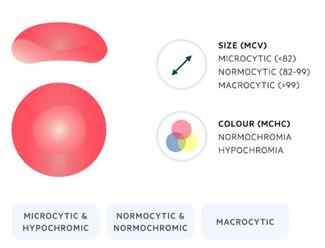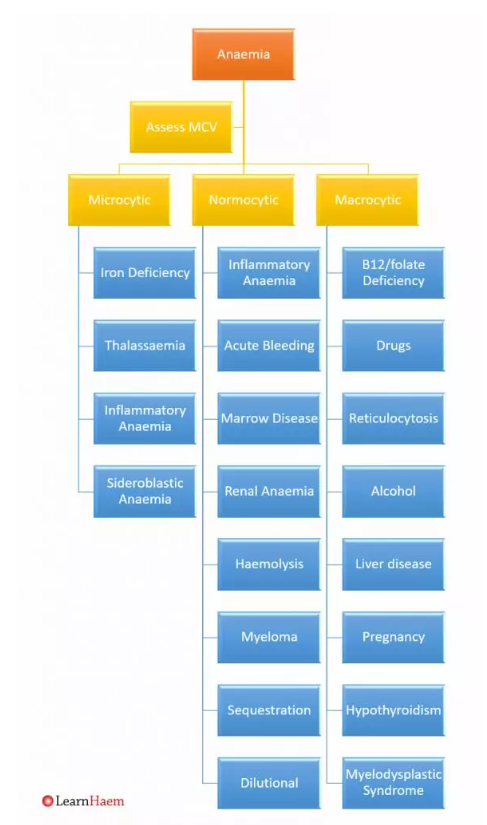Anaemia Morphological classification
Classifies the causes of anaemia based upon
- Mean corpuscular volume (MCV).
- Corpuscular Colour

A normal RBC is approximately 7 microns in diameter.
The MCV is a measure of the average volume of a RBC.
The MCV is measured in femtolitres (fL)
and usually resides between 82 and 99.
RBCs that are > 99 fL are referred to as macrocytes,
RBCs that are < 82 fL are referred to as microcytes.
The MCV is a measure of the average volume of a RBC.
The MCV is measured in femtolitres (fL)
and usually resides between 82 and 99.
RBCs that are > 99 fL are referred to as macrocytes,
RBCs that are < 82 fL are referred to as microcytes.
Normocytic Anaemia
Anaemia is described as normocytic
when the MCV is within normal limits (82-99 fL).
The causes of normocytic anaemia
are extremely broad
and it may reflect the early stages
of either a microcytic or macrocytic anaemia.
Anaemia may be the first manifestation of a systemic disorder.
One of the most common causes of a normocytic anaemia is
‘anaemia of chronic disease’.
Other common causes of a normocytic anaemia include
- blood loss,
- renal disease,
- cancer-associated anaemia
- and pregnancy.
Macrocytic
Anaemia is described as macrocytic when the MCV is > 99 fL.
There are numerous causes of a macrocytic anaemia,
but it is commonly secondary to folate and/or B12 deficiency.
Folate and B12 deficiency cause a megaloblastic (immature) macrocytic anaemia
and abnormal nucleic acid metabolism.
Drugs that interfere with nucleic acid metabolism
may also cause a macrocytic anaemia (e.g. methotrexate).
Other important causes of a macrocytic anaemia include:
- Alcohol abuse
- Liver disease
- Hypothyroidism
- Haematological malignancies
- Reticulocytosis

Microcytic
Anaemia is described as microcytic when the MCV is < 82 fL.
Microcytic anaemia
is commonly associated with
a reduction
in the mean corpuscular haemoglobin concentration (MCHC),
which leads to the appearance of pale (hypochromic) RBCs.
The most common cause of microcytic anaemia
is iron-deficiency anaemia (IDA).
This may be evaluated with
iron studies (transferrin and serum iron)
and serum ferritin.
Other important causes of microcytic anaemia include:
- Anaemia of chronic disease
(predominantly causes normocytic anaemia)
- Thalassaemia
- Other haemoglobinopathies
- Lead poisoning
- Sideroblastic anaemia





